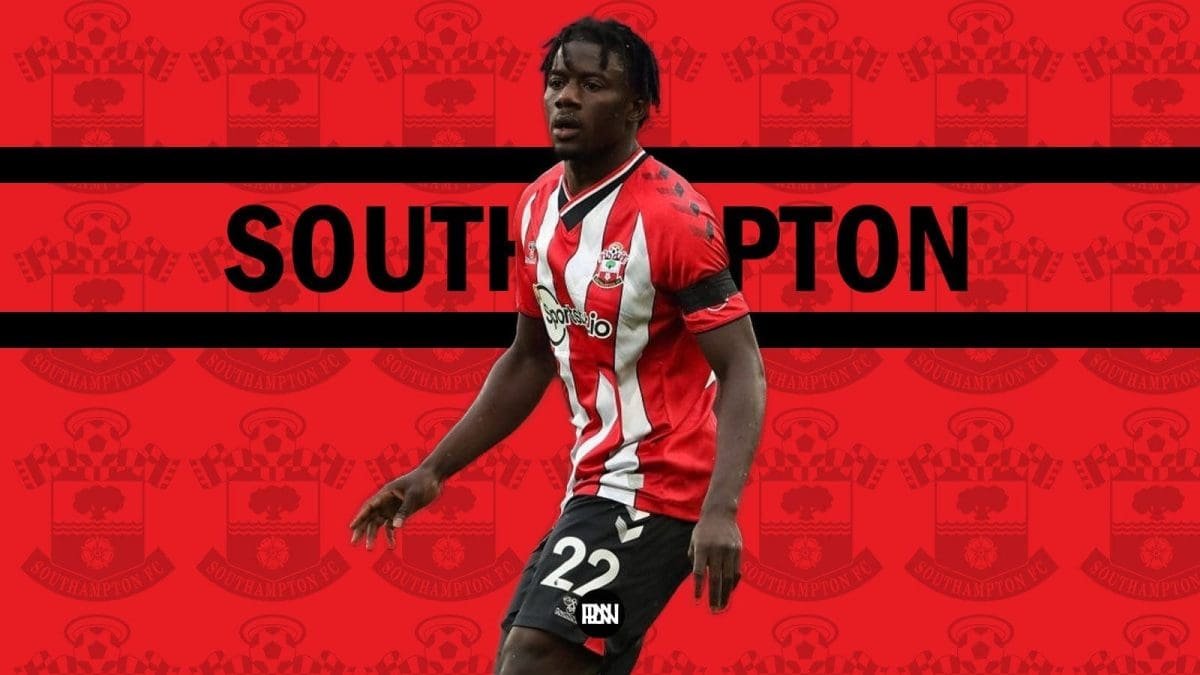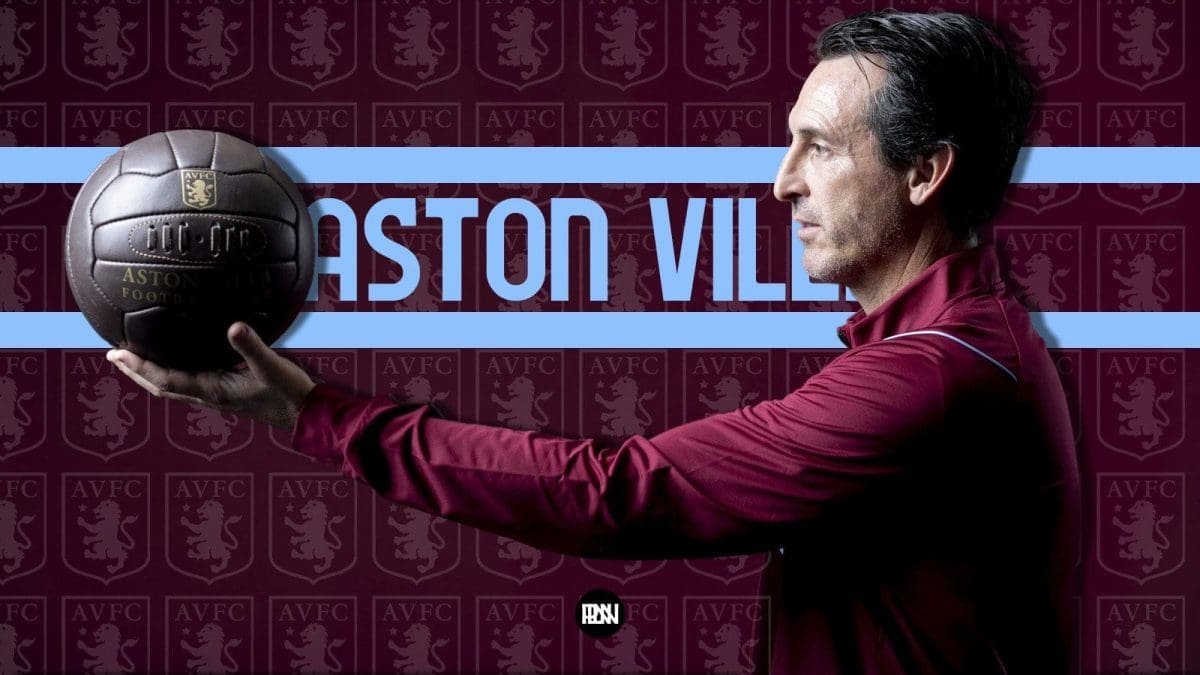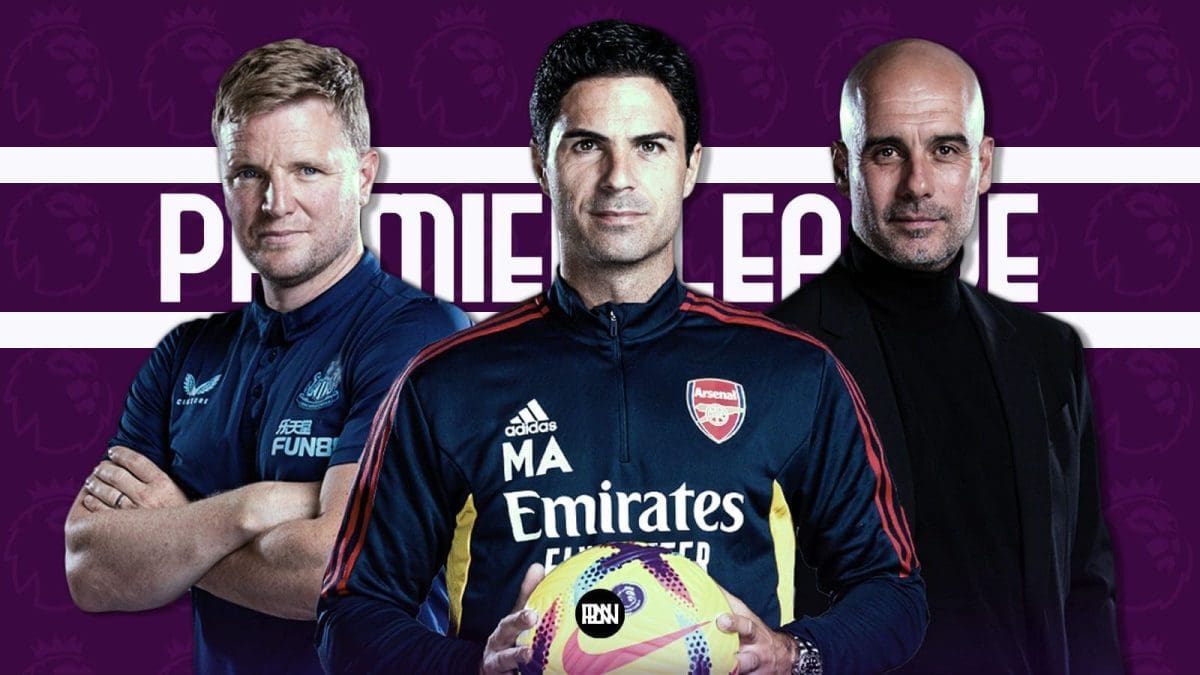Mohammed Salisu delivered yet another impressive performance right before the international break. At the home of the European champions. The Ghanaian continued his stellar start to the season and has been a bright spot (among others) for a Southampton side that have struggled for results so far this season. Despite their slow start, Salisu has produced superb individual performances to help Ralph Hassenhuttl’s side take points off both Manchester clubs, a remarkable feat.
His ability to be calm and calculated mixed with an aggressive approach to defending has helped Southampton create a defensive block that has so far frustrated the attacks of three top contenders for the title. With Chelsea being the only one of the three sides to emerge with a rather hard-fought win against the Saints’ defense.
This article provides an analysis of Salisu that will show you why he has looked so dominant against elite teams, why his current level of performance is here to stay and why you can expect bigger things from the 22-year old. It analyses his abilities through the prism of the different phases of a football match and show how well he performs in each phase.
PHYSICAL ATTRIBUTES
Salisu stands at 191 cm. His slightly long legs have a bow-legged appearance, he has a relatively low center of gravity for his height and it gives him immense balance and strength on the ground, making him insufferable in ground duels. He doesn’t have a lot of muscle or weight on his upper body which gives him great hip mobility and an ability to shift his body weight quickly to any feet. He’s quick with both feet and isn’t one footed in duels like most left-footed CBs. As a result he can poke the ball away with any foot and switch his body orientation quickly.
He’s also very quick off the mark, accelerates fairly quickly and maintains an impressive top speed. He has matched strides with Timo Werner, showcasing his impressive speed.
IN POSSESSION
Build up
Salisu is very comfortable with the ball at his feet and is never scared to receive passes under pressure. He prefers to stay deep and/or wide on the left side of the defence to stretch the opponent’s first line of pressure, from where he can play passes in behind them to the midfield pivot or deep lying midfielders. These tendencies make him a good fit for teams that wish to dominate possession or teams that employ patient build up strategies.
As much as he is comfortable with the ball at his feet, he is also very mature on the ball and doesn’t take unnecessary risks. Knowing when to clear the ball or play it into the channels if the need arises. He plays well weighted passes to the LB which allows the LB to receive with minimal risk of being dispossessed. As a very mobile CB, he can offer support to the LB by dropping deeper after passing to give the LB an option to release the ball when pressured. When Southampton use a back three in build ups he is often seen attempting give-and-gos and making runs ahead of the LB, displaying his mobility and fluidity in possession.
Progression
Salisu’s preferred pass in this phase is a short-medium length pass to the halfspace for a winger, AM (or SS in a 2-man attack) to receive on the turn. He shows an impressive ability to break opposition lines. He is able to recognize passing opportunities after opponents have been baited out of these zones and releases the ball timely to instigate attacking moves. His ball striking is average so he doesn’t attempt to switch play very often, and instead prefers low risk passes that don’t put the team at the danger of losing possession.
He also favours a pass into the channels. But as a result of his average ball striking he is only comfortable playing chipped and floated passes into the channels and not curved/wrapped balls that are useful for releasing runners and catching defenses off guard. His passes into the channels often require the forward to duel or challenge defenders before receiving the ball as opposed to receiving the ball in the channels first before holding off challenges.
He doesn’t show a strong likeness for carrying the ball, but his willingness to run ahead of his defense can be a useful tool for ball progression, though it is currently under-utilised when Southampton have possession.
Penetration
As mentioned earlier, Salisu possesses average ball striking so he doesn’t play passes in behind opposition defenses and generally doesn’t attempt or excel at long range passes; he isn’t a powerful ball carrier which means he doesn’t go on those Antonio Rudiger esque runs with the ball at his feet to disrupt opposition defences. His only contribution to breaking down defences come from his mobility and is best utilized in a back three formation.
He shows a good understanding of what positions to take up to facilitate penetration and uses this ability along with his technical security to sustain attacking moves and/or create overloads around the opposition defence.



OUT OF POSSESSION
High press/block
When teams press high, it is essential that their CBs are strong defensive duelers to allow them win “50-50” duels and recover the ball if the opposition clear it up the pitch. Their CBs also need to make good decisions on the ball after it is recovered to prevent losses of possession which can put the team at the risk of a counter-attack if the opposition win possession while most of the team is caught high up the pitch. Salisu excels at dueling and at making good decisions on the ball. He is strong and assertive in his duels and his calm and safe use of the ball ensures that Southampton can keep possession when they win the ball high up the pitch.
One key trait that allows Salisu to safely win duels high up the pitch is quite contrary to the purpose of the duels. Which is that he is never obsessed with winning the ball and doesn’t dive into challenges. Rather he gets tight on his opponents and simply prevents them from turning towards goal or playing a forwards or sideways pass. This move seeks to prevent the opposition from progressing the ball and causes them to lose possession in the process by limiting their options on the ball.
He does it with the utmost intelligence and a good sense of timing, an intelligence that shows in his ability to decelerate right before engaging his opponent. This prevents the opponent from dribbling past him by using his momentum against him and gives him the chance to quickly adjust his body weight if the opponent tries to beat him with a quick turn or tricky touch.
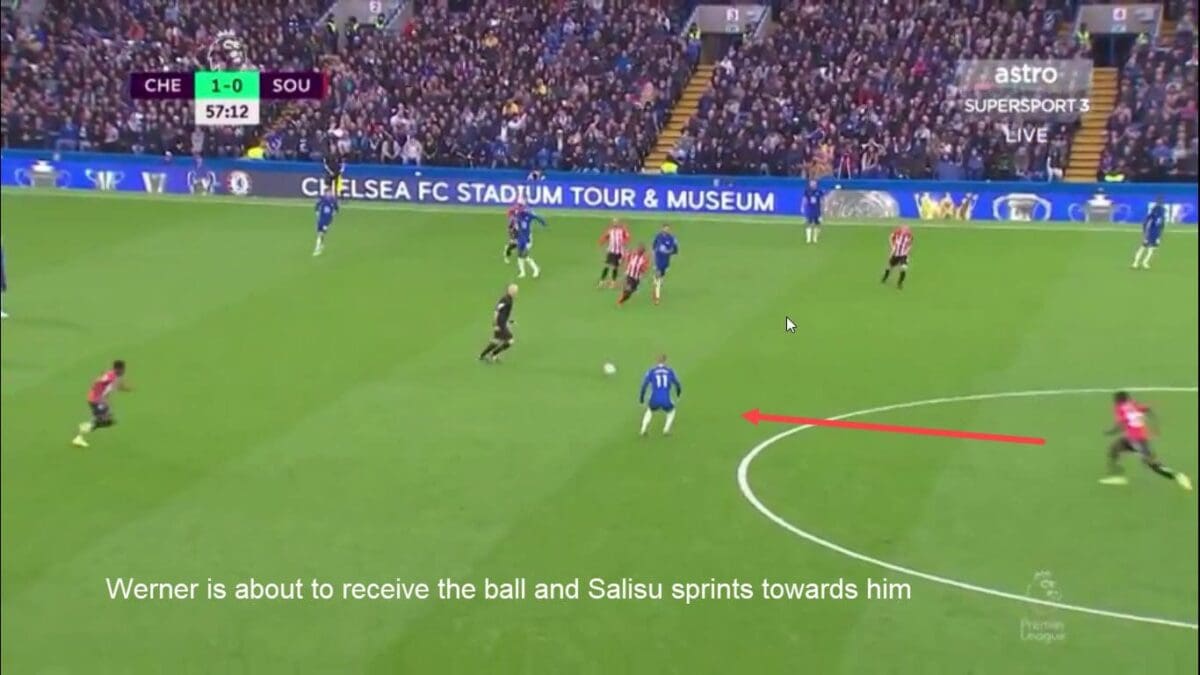
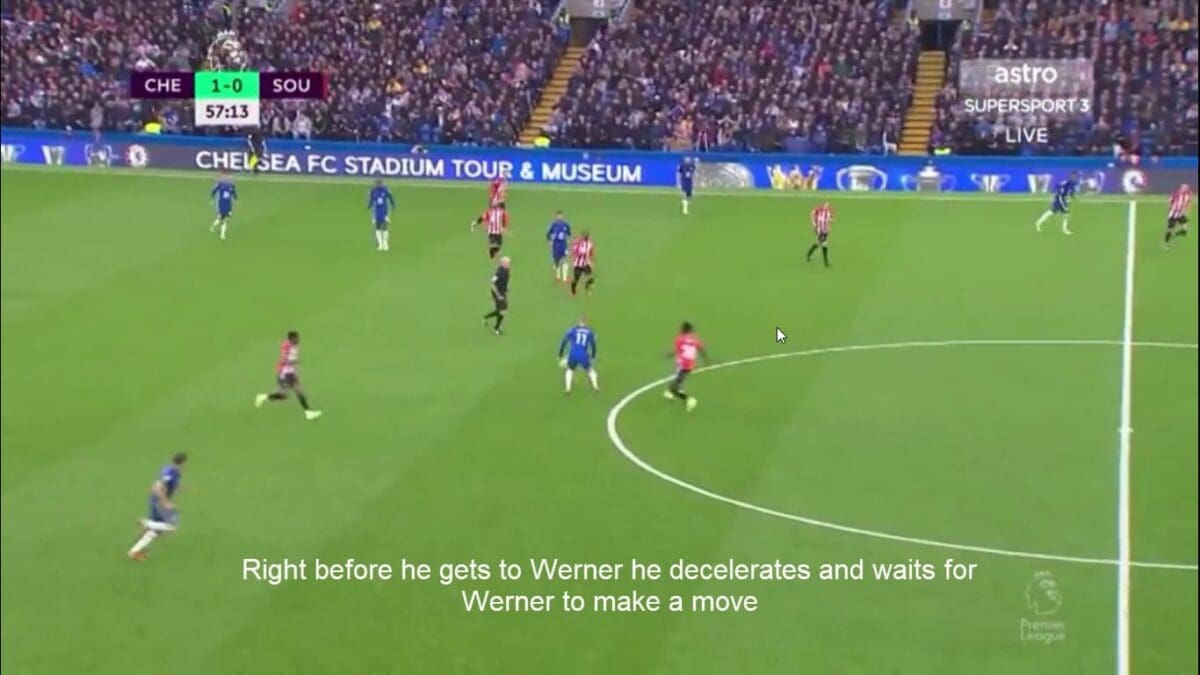
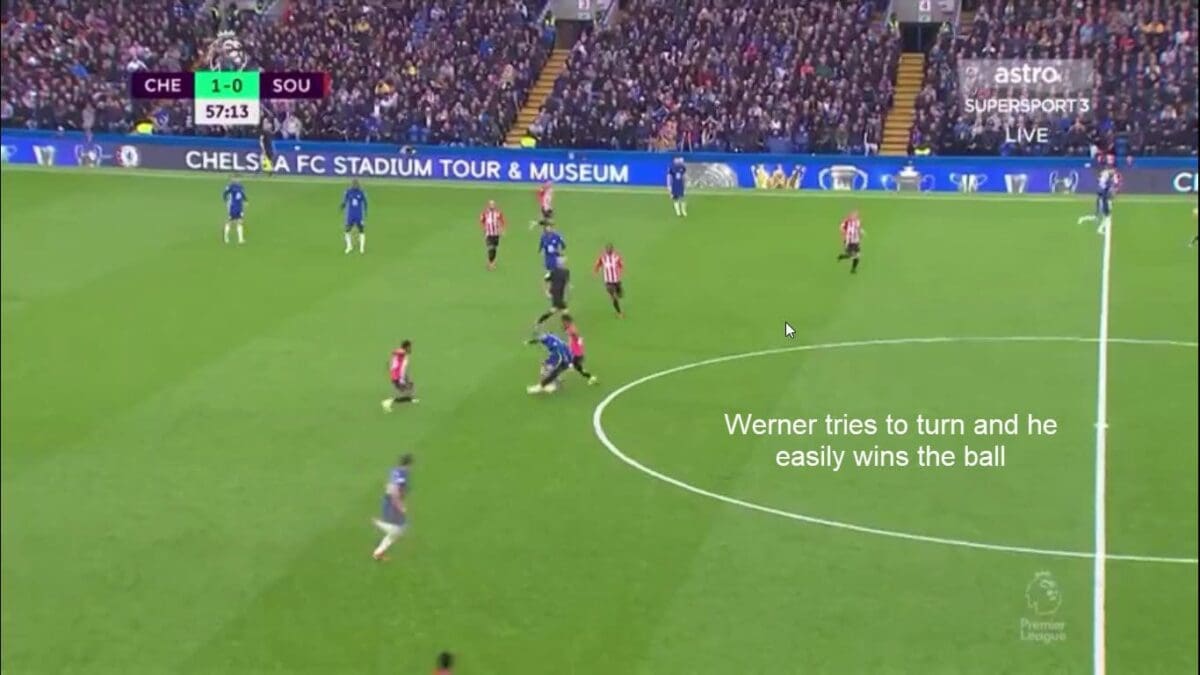
Mid block
In this phase Salisu employs the same principles he uses when dueling in a high block. He gets tight on his man and prevents them for progressing or turning to face play. He combines his willingness to step out of the defensive line and be aggressive when hassling opponents into losing possession with his ability to anticipate danger and track the movement/runs of opposition forwards.
His quick feet, strength and balance allow him to quickly sort out his feet or switch his body weight from one leg to another. This is useful in the event of a misplaced pass or when the opposition try to progress the ball into the spaces between the lines. He is able to react faster than forwards and win possession by getting to the ball first.


His deceleration right before he engages his opponents is also important in this phase. It keeps him from diving into challenges and also ensures that he doesn’t give away potentially dangerous fouls around the penalty area by being rash in his duels. If the opponent makes a lay off pass or takes a quick touch when he gets tight on them, he can still shift his weight quickly and protect the space behind him.

When facing a mid block, teams often seek to progress the ball via the channels. Salisu excels at contesting duels in the channels because of his strong legs and speed. Allowing him to match the pace of most forwards and outmuscle them. In the game against Chelsea, he nullified one of Chelsea’s main modes of progression into the final 3rd in Timo Werner by constantly winning all the duels in the right channel.
Low block/Box defending
One of the key traits that Salisu excels at in defending his box and a trait that makes him stand out as a defender in general is that he trusts his teammates to do their own defending. He doesn’t try to take on too much responsibility and can “delegate” certain tasks to his teammates. Even though those teammates might be seemingly worse defenders than him he always maintains good defensive principles as opposed to trying do everything himself.
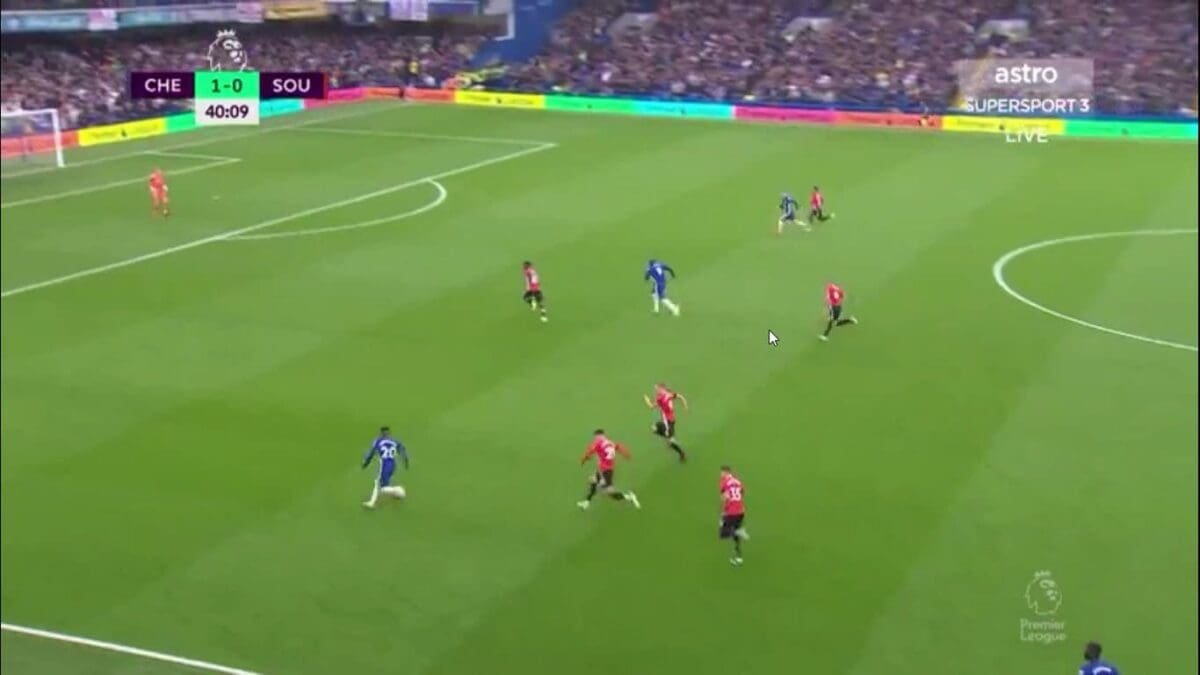
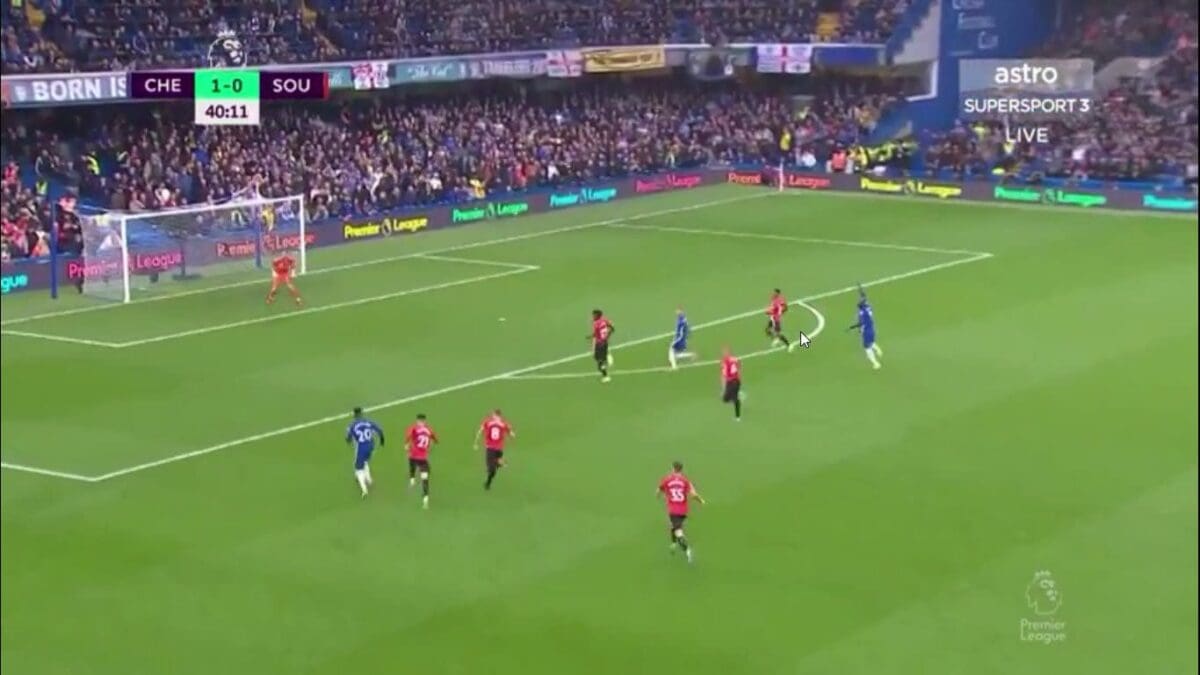
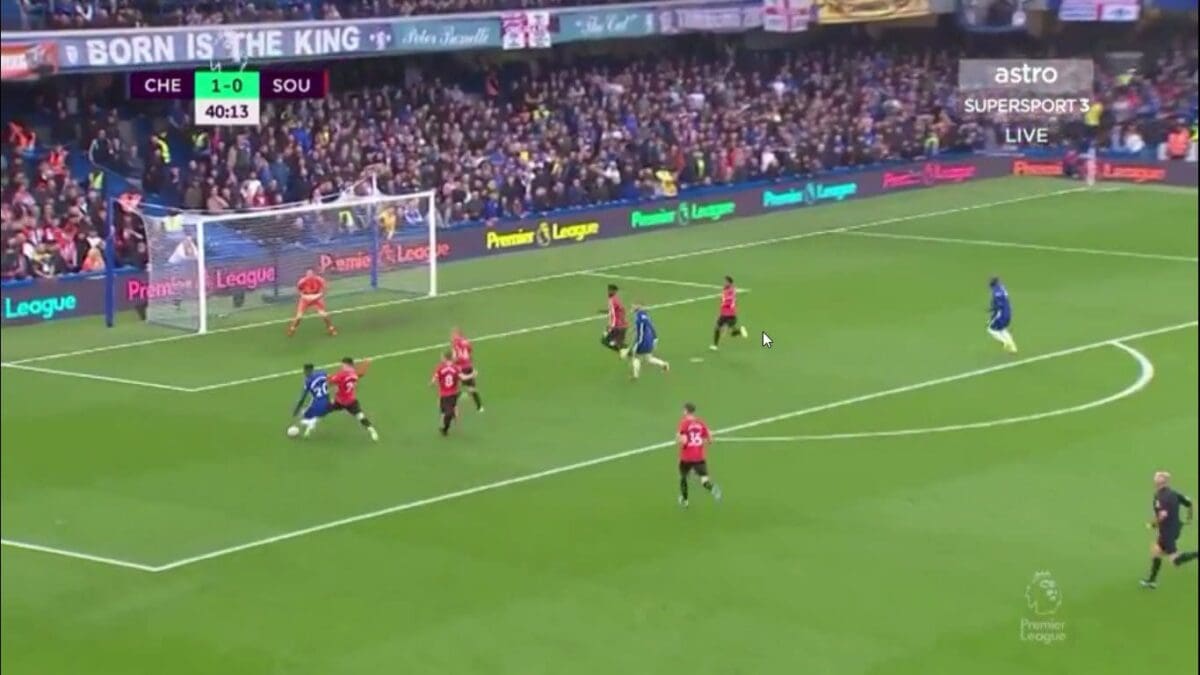
Trying to take on too much responsibility as a defender often leads to bad decisions, dueling in poor positions and exposes space in the defense for forwards to attack. Salisu shows good trust in his teammates and it is an ability that will translates well to better teams because he’ll get to play with defenders of a similar level. Maintaining good defensive principles and trusting teammates to do their jobs helps to maintain the defensive structure and compactness.
This style of thinking shows in the zones he prefers to defend in the box. He prioritises the space in front of the last line of defence and leaves the face of the goal for the goalkeeper and ball far CB to defend. Likewise, when the ball is on the left side of the opposition’s attack he defends the face of the goal and frees up his CB partner to step out and defend the space in front of the defense line.

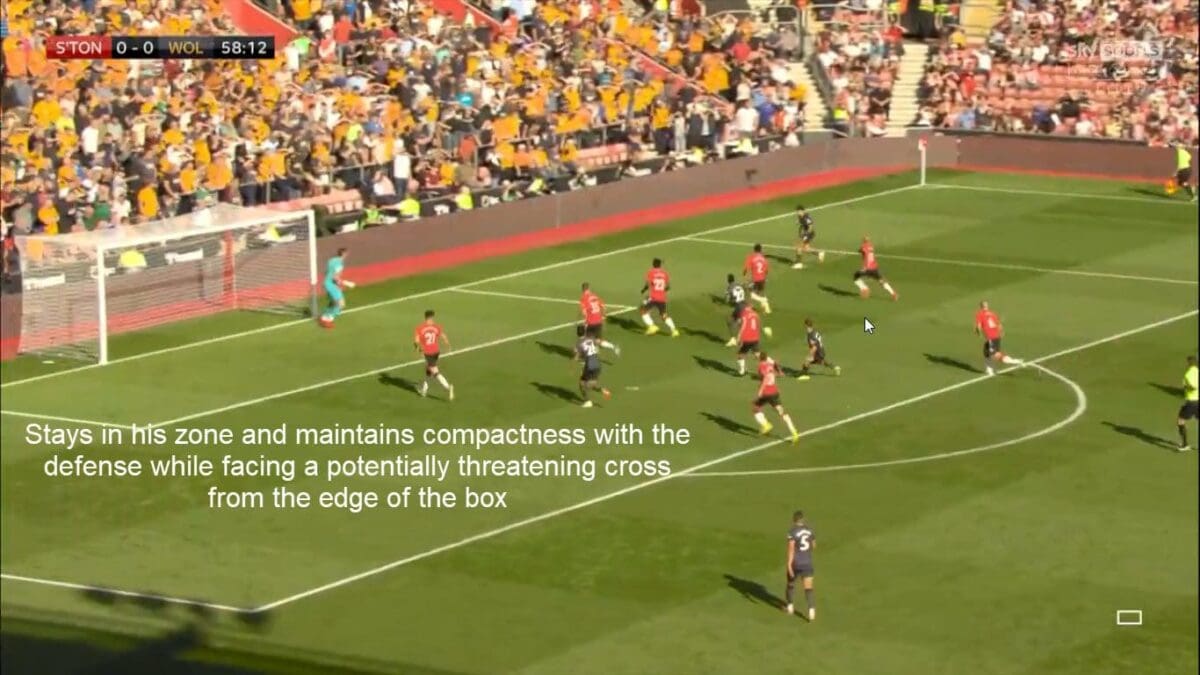

When defending crosses, he knows to stay close to potential threats and his height allows him intercept crosses fairly easily. He makes some difficult clearances and interceptions look quite easy because his positioning in the box always nullifies the nearest possible threat.

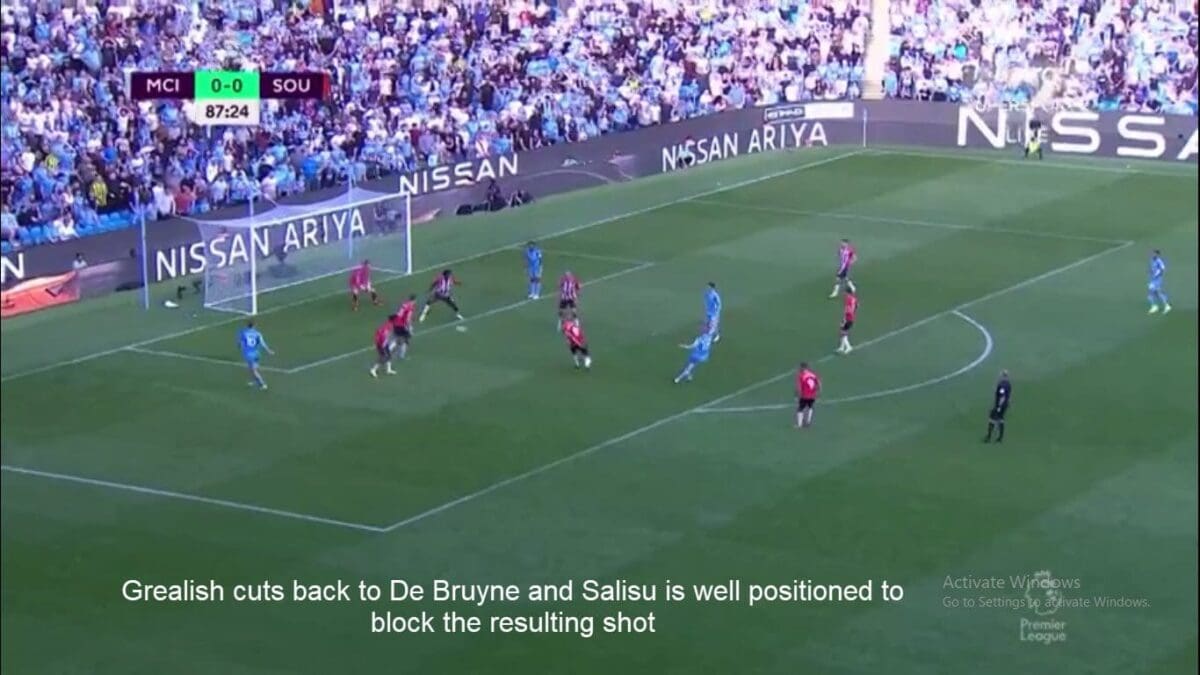
TRANSITIONS
In offensive transitions, Salisu prefers a quick, short and well-cushioned pass to the nearest midfielder to kickstart an offensive transition. The weight on the pass is important because it allows the ball receiver to receive with little risk of losing the ball and find more dangerous passing options. This shows his constant awareness of space and his teammates’ positioning and that awareness allows him to make quick decisions upon winning possession.
Where Salisu really excels though, is his decision making in defensive transitions. He understands the importance of delaying his confrontation and always picks the right moments to make challenges. He limits the opponent’s options with his positioning and huge frame and simply waits for them to make a poor decision or turnover the ball in their attempt to play around him. Another benefit of his ability to delay duels is that he maintains compactness with his defence at all times (or compactness around the dangerous opposition players) and allows the recovering players to get into good defensive positions.



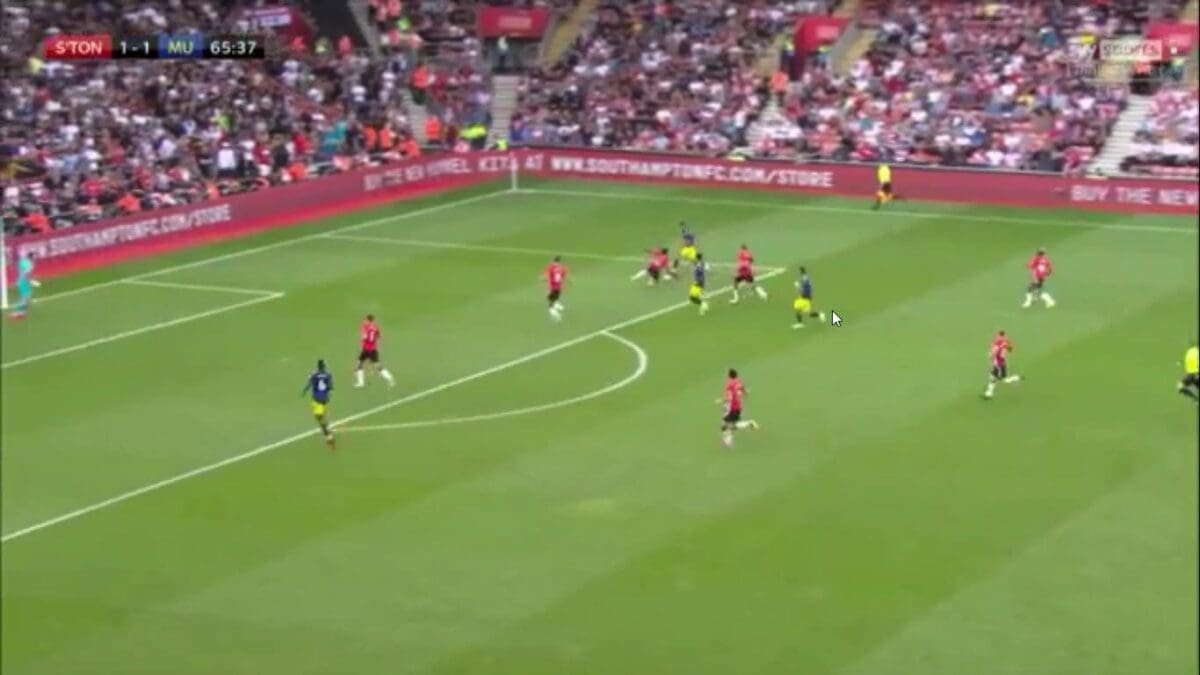
MENTAL ATTRIBUTES
Communication
Salisu is a reserved leader in Southampton’s defence. He isn’t very vocal or “loud around the place” which is to be expected from a non-native English speaker who is relatively new to the premier league and the squad. But he displays a lot of good leadership qualities, communication and organization at the back. He’s often seen admonishing more senior members of the squad when they lose concentration or make a wrong decision. He’s not shy to coordinate things and take responsibility and this is visible when Southampton have possession or are building out from the back. He constantly communicates to direct the flow of possession and indicate the right spaces for the ball to be played. During set-pieces, offensive and defensive alike, he organizes and structures the arrangement of the players, showing them the right positions to be in.
Assertiveness
Salisu is always calm and collected on the pitch and backs himself in duels. Whether it be duels in the channels, in midfield, by the sides of the penalty box or in front of the defence. He goes into duels with 100% conviction and controlled aggression. He’s not afraid to get tight on forwards and hassle them into losing the ball and is firm in his challenges/tackles, making sure to leave a mark on his opponents.
Scanning/Awareness
All the sections before this have subtly or overtly highlighted Salisu’s superb decision making. But decision making doesn’t exist in a vacuum. And one of the main pillars of his decision making is the fact that he constantly accesses his surroundings and scans the spaces around the defence. He uses the information from that scan to make the right decisions at all times.
Scanning provides information like the position of opponents in and around the penalty box, the number of his teammates available to defend a specific position and the possible thought process of the opposition player on the ball.



He demonstrates his awareness and decision making in this sequence



In the following sequence he combines some of the aforementioned qualities and shows some world class defending to prevent what would normally be an easy goal for Jimenez or Adama and keeps Southampton in the game. Note the awareness of Adama’s position, his reading of Jimenez’ intentions, the intelligent use of his frame/legs and the trust in McCarthy to save the resulting shot.



Needed improvements
One area Salisu will have to improve on is his aerial dueling outside the box. He stands at 191cm and has very strong legs but isn’t comfortable reading the flight of long balls and often mistimes his headers. He wins duels in the air when he has space to run onto the ball, but he won’t always be afforded that space and struggles to win aerial duels when up against big forwards. The good thing is this is one aspect of defending that can be improved through practise and training so he should improve as he gains more experience and training.
Conclusion
Salisu shows a level of decision making, leadership and solid defensive education that evade most of his peers and is well on the path to becoming a complete profile as a CB. His huge frame, nimble as well as strong legs, hip mobility, defensive awareness, calmness, concentration and technical ability are qualities that translate well to any team. And upon further development and avoidance of injuries he will soon be in the elite crop of CBs.


